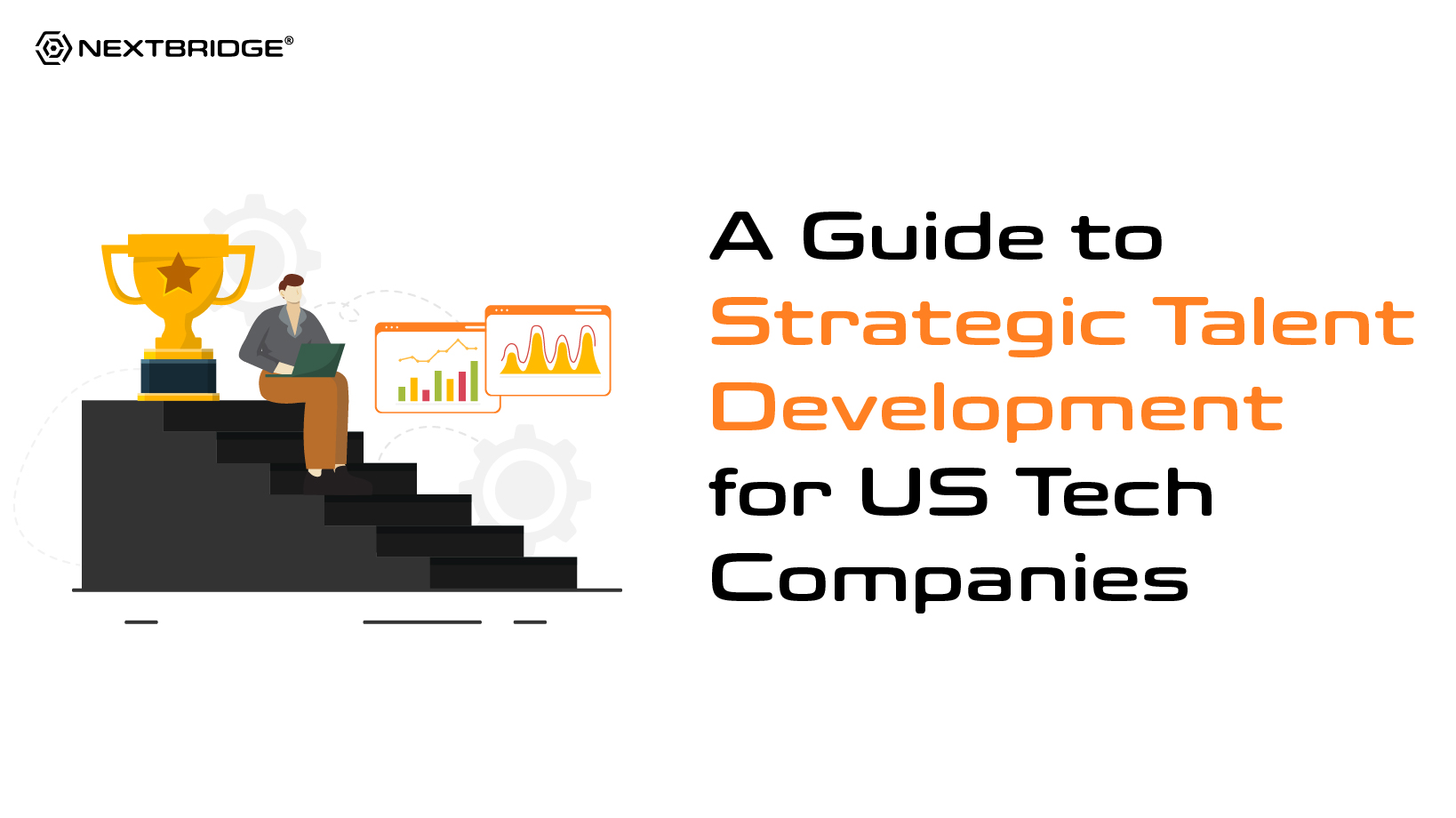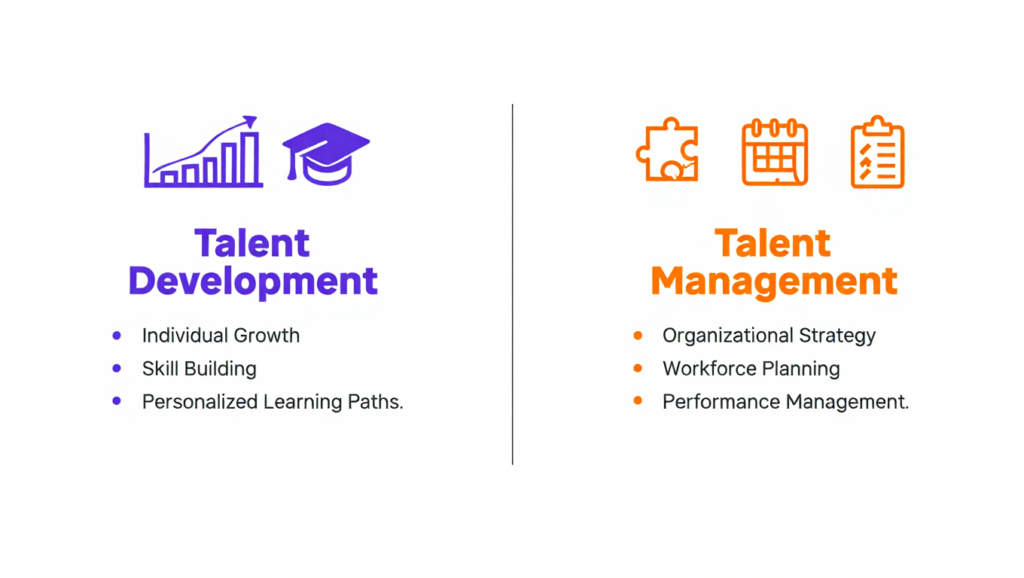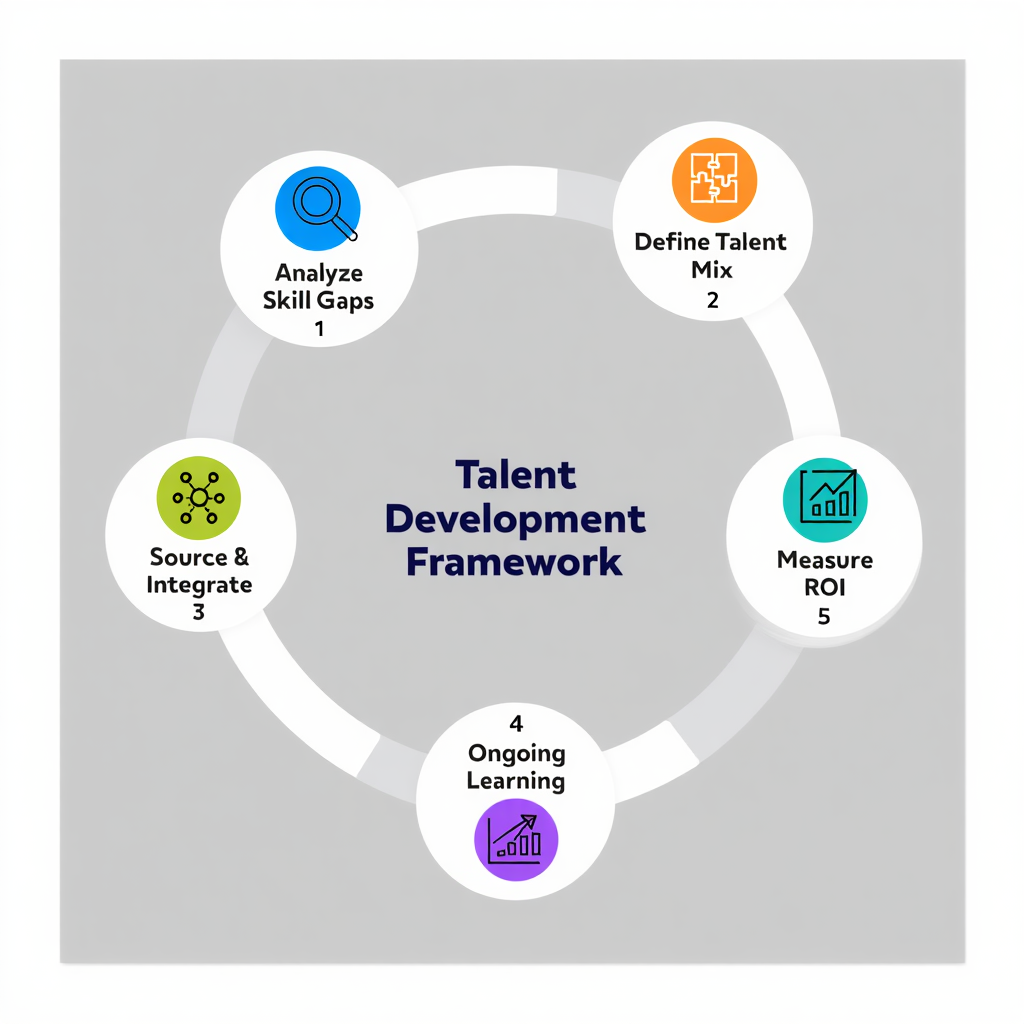 Back to all articles
Back to all articles
Blogs
A Guide to Strategic Talent Development for US Tech Companies (2025)


Introduction
We all know that the tech industry in the USA is being affected by an exceptional talent crisis. With the quick digital advancements, increasing demands for hybrid models, and changing business requirements, organizations face difficulties in retaining their workforce and developing the skills they need to compete in the market. This is why traditional methods of hiring and training employees do not seem sufficient anymore. Now is the time for organizations to rethink identifying and growing talent.
Today, the goal is not to fill the vacancies but to create a strategic approach that helps organizations develop skills for their workforce that align with the future demand. At this point, talent development strategies become critical. Let’s understand the concept of talent development, how it differs from talent management, the hybrid model, and the future.
What is talent development: Beyond Buzzword
You might have heard about talent development that goes beyond being a buzzword. If you want your business to compete in today’s digital world and tomorrow, you need to focus on your people, the most valuable asset. This is where talent development becomes your priority, as people make a huge difference. But what is talent development exactly, and why is talent development important? Let’s explore.
Talent development is the process of providing training and learning opportunities to the workforce to expand and grow their effectiveness. Through this process, you develop your workforce’s skills, knowledge, and confidence strategically, so that they can perform according to overall organizational goals. You identify their existing knowledge and skillsets, identify gaps, and fill those gaps to start a journey of desired business performance.
The importance of talent development lies in the fact that if implemented effectively, the process itself is a high return on investment for companies. Upskilling their workforce helps them prepare future leaders and gives employees a sense of care towards their career growth.
Talent Development vs Talent Management
The terms talent development and talent management are considered alternatives for each other. Both are important for your employees’ and eventually your business’s growth, but possess different meanings. The primary focus of talent development is to develop, motivate, engage, and retain current employees, aligning them with their professional goals and long-term, broader organizational goals.
Contrary to this, talent management is a wider strategic approach that manages workforce potential in the organization. Talent management refers to a broader range of human resources functions that attract, recruit, develop, and retain employees. Activities like managing employee performance, succession planning, and engagement programs for the employees.
Review this table to clearly understand these terms and never get confused next time.

| Talent Development | Talent Management |
| Contributing within the organization.Growing in experience and skills.Meeting goals that are aligned with the long-term goals of the company. | Attracting talented applicantsInitiating the journey of new hires effectivelyKeeping employees engaged and retaining them |
The Hybrid Talent Development Model
Although the importance of IT talent development has increased more than ever, it is not as it seems, especially in a hybrid working model. In the middle of the war between talent, the digital transformation, the Great Resignation, and work-from-home models development of the tech workforce has become more significant as well as harder.
In the hybrid model, you integrate both in-house and augmented teams, which results in interpersonal and logistics issues. While putting efforts to keep a shared vision and a sense of unity among both teams, organizations face difficulties that revolve around tech talent development. Now you are aware of the very reason organizational leaders must prioritize the development programs for IT talent to ensure that the retention rate is high.
Have a look at the following table and learn how to create an IT talent development program with 5 tips.
| Tips | Why Needed | How to Implement |
| 1. Avoid over-selling or under-delivering | During the recruitment process, employer branding is important, as it reduces the chances of turnover only when it is accurate. Do not deliver any message to candidates that you think they want to hear; instead, share the reality of what it is like working for your company. | Invite current IT employees to contribute through the e-suggestion platform. Ask them which IT areas they are performing excellently in.Train all the hiring managers enough so that they can communicate responses to the job candidates and discuss what actually happens at the workplace. |
| 2. Execute intentional hybrid onboarding | A hybrid workplace comes with one common challenge for new recruiters while onboarding: an informal familiarity with the organization. Such a setting does not offer opportunities for casual onboarding and in-person meetings with new hires. This creates a need for executing intentional hybrid onboarding. | Be purposeful while scheduling meetings, collaboration sessions, and presentations.Ensure that all the stakeholders are involved. Conduct sessions to engage the new employee, convey the relevant information for better performance, and give opportunities for relationship building with colleagues. Provide them with virtual opportunities with the above-mentioned goals. |
| 3. Provide options for a specific career path | IT talent development is becoming increasingly important as technology contributes more to bringing business success. To keep succession planning a priority, businesses must upgrade technological skills and leadership capabilities. Remember that each team member is unique, having unique but different goals. Align talent development programs with their interests and capabilities. | Encourage employees to dedicate a part of their working hours to building their brand with expertise in the domain. Support employees and facilitate them to arrange in-person meetings, and encourage them to speak about their speciality.Encourage them to host career development programs. |
| 4. Invest in evaluations | Career paths in the IT industry serve both the individuals and the organizations. To make it happen, you need to look for the required skills. That is where you need to invest heavily in assessments of your employees, understand how much they are capable of leadership roles, and what motivates them to perform. | Motivate IT professionals and HR partners to indulge in proactive conversations. Enable IT leaders to represent the interests of their teams in talent development programs and discussions. Align assessment goals of IT employees with talent strategies at the organizational level. |
| 5. Ensure pivotal positioning of IT | IT professionals view certain projects as meaningful to the organization they work in, but often face a lack of opportunity to work on them. Most of their work involves keeping the technical systems operating smoothly and fixing the errors. If the company overlooks employees’ interests and capabilities, it is dangerous, especially in a work-from-home model. | Instead of viewing it as a support function, consider the role of IT teams as important for the organization. Ensure that the IT strategy aligns with the business strategy and supports it. Encourage the contribution of IT team members through strategic involvement. |
The 5-Step Talent Development Framework
How do you manage talent development? Do you consider training sessions while ignoring the implementation of talent development strategies? If yes, you need to create a long-term framework that bridges the gap between the growth of employees and the success of the organization. Here is a 5-step talent development framework you need to work on today:
Step 1: Analyze Skill Gaps and Employee Needs
In the first step, identify where your team stands today. While doing so, carry out the skills gap analysis and find out what and where current skillset employees lack to achieve business goals. Look deeper into their current skills and compare them with skills your business actually needs. You will be able to identify the hidden strengths and areas of improvement.
Do not perform skills gap analysis only once; rather, consider it an ongoing process. Collect information related to employee performance from different resources, including:
- Self-assessments
- Performance reviews
- Feedback from the manager
- Skill assessment tools
Example: During skills gap analysis, you find out that the engineers have expertise in Python and Java, but they are not experienced in cloud app management. This is where you need to train them with tools like Docker and Kubernetes.
Step 2: Define the Talent Mix
If you want your organization to be successful, finding people just to fill the positions is not enough. You need to understand that developing the right talent strategy is the basis for success. For this, you need to have a clear understanding of:
- Finding the right people
- Putting them in the right place
- Creating the right culture
This is what the second step in the talent development strategy is all about.
Define the talent mix by mapping out the right combination of roles, skills, and capabilities required by an organization in its employees, with the aim of accomplishing business goals. Here, instead of filling up the vacant roles, be intentional in deciding the accurate blend of soft skills, technical skills, industry expertise, and leadership qualities.

Step 3: Source and Integrate the Talent
In the third step, find the right talent and integrate it into your organization. Talent sourcing is an approach to identify and engage potential hires to fulfill current and future needs. It is more than just filling the open jobs: it requires deep research, careful planning, networking, building relationships, and eventually, creating a pool of talented candidates.
Talent integration is equally important. This applies to both new employees and existing employees, shifting to the new roles inside the organization. If implemented well, the process of talent integration facilitates all the team members in:
- Adapting to their roles and responsibilities
- Aligning with the culture of the company
- Feeling personally and professionally supported
Like many other organizations, if you overlook sourcing and integrating the talent, you will end up missing or detaching the employees with potential.
Step 4: Create Ongoing Learning and Development Strategies
A healthy organization for employees focuses on continuous growth with ongoing learning and development strategies. Such strategies are the foundation for promoting the potential of your employees in the long run. These strategies are about creating and providing opportunities for:
- Upskilling
- Reskilling
- Working on cross-functional projects
- Career advancement
- Mentorship
- Coaching
Providing employees with a clear path at the front with learning and development strategies makes them feel engaged, and their commitment to their roles and your organization increases. Start investing in the skill development of your team members so that they are not only prepared for the upcoming challenges but also feel valued on their professional journey.
Step 5: Measure Return on Investment
We have already discussed in the previous step that talent development is a long-term, continuous process. So, you need some quantitative metrics to measure the success of your strategies and develop tech talent in your organization. In step 5, develop relevant key performance indicators (KPIs) that include:
- Employee engagement rates
- Employee retention rates
- Indicators of operational efficiency: project completion and delivery rates, speed to market
- Customer/client satisfaction rates
- Financial metrics: profit margins, revenue growth
In addition to quantitative metrics, track qualitative metrics by obtaining regular feedback and suggestions from participating employees and their managers. When you apply the 5-step talent development plan continuously, it results in a consistent cycle to evaluate needs, grow talent, and align with changing business needs.
Future Trends in Talent Development: AI, Web3, and Evolving Skillset
With the evolution of AI transformation at the workplace, organizations are planning more personalized talent development strategies with learning experiences based on real-time data. They are using AI tools to
- Evaluate skills gaps
- Suggest customized training programs
- Anticipate the future needs of the workforce
All these practices are helping employees in the quick development of a relevant skillset. Far-sighted companies integrate AI into their talent development strategies and adapt to the culture of continuous learning. This way, they prepare employees for changing roles and ensure compatibility with evolving business dynamics.
As for the integration of Web3, it is and continues to innovate talent development strategies through ecosystems that are:
- Decentralized
- Transparent
- Based on recognized learning
If we talk about the integration of AI with Web3, it is innovating the way companies create talent development strategies more measurable, engaging, and consistent with the changing needs of business and technology.
Conclusion
With strategic talent development becoming more important than ever, USA tech companies are bridging skill gaps and aligning the capabilities of the employees with organizational goals. By doing so, they are preparing their workforce for shifting roles and responsibilities. In addition to this, they are making the most of the integration of AI and Web3. This way, they are making their structure competitive, which prepares them for whatever is coming in the future.
Don't hire us right away
talk to our experts first,
Share your challenges, & then decide if we're the right fit for you! Talk to Us
Partnerships & Recognition
Commitment to excellence






